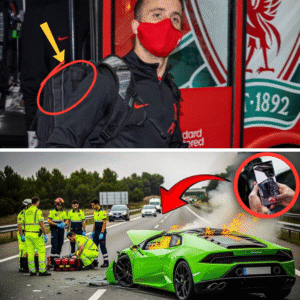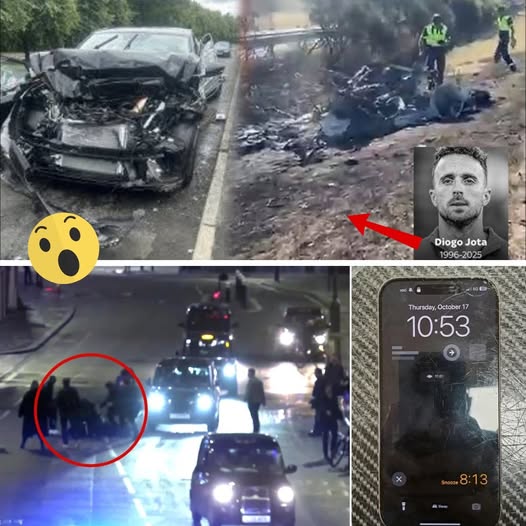EXCLUSIVE LEAK: Mysterious Circumstances Surround Diogo Jota’s Fatal Car Crash
On July 3, 2025, the football world was rocked by the tragic deaths of Liverpool star Diogo Jota and his brother André Silva in a fiery car crash on the A-52 motorway near Cernadilla, Spain. The brothers were traveling in a Lamborghini Huracán when the vehicle veered off the road, rolled, and burst into flames. Initial reports from Spanish authorities suggested that excessive speed and a tyre blowout were the primary causes of the accident. However, a leaked drone video has introduced a perplexing new dimension to the investigation, raising questions about what—or who—caused the car to behave erratically before the crash. Engine experts analyzing the footage have described the vehicle’s behavior as “as if another woman was remotely controlling it,” despite the Lamborghini model lacking any remote control system. This article delves into the details of this exclusive leak, exploring the implications and possible explanations for this mysterious phenomenon.
The Crash: A Tragic Loss

Diogo Jota, a 28-year-old Portuguese forward for Liverpool FC, and his 26-year-old brother André Silva, a professional footballer for Penafiel FC, were en route to Santander, Spain, to catch a ferry to the UK. Jota, recently married and a father of three, had been advised against flying due to a recent lung surgery, prompting the brothers to undertake the road trip. The accident occurred around 12:35 AM local time, when their acid-green Lamborghini Huracán, capable of reaching speeds up to 200 mph, reportedly suffered a tyre blowout while overtaking another vehicle. The car careened off the A-52 motorway, rolled, and ignited, leaving emergency responders unable to save the brothers. The intensity of the fire destroyed much of the vehicle, complicating initial forensic efforts.
Spanish police, led by the Civil Guard, have been investigating the crash, focusing on skid marks and forensic evidence suggesting that Jota was likely driving and that the vehicle was traveling above the speed limit. A preliminary report indicated that a tyre blowout, possibly exacerbated by high speed, caused the loss of control. However, conflicting accounts have emerged, with a truck driver, Jose Azevedo, who witnessed the crash, insisting that the car was not speeding. Azevedo, who filmed the aftermath, stated, “I filmed it, stopped, tried to help, but unfortunately, there was nothing I could do.” Another truck driver reported that the Lamborghini was traveling at a “moderate speed” five minutes before the crash. These discrepancies have fueled speculation about the true cause of the accident.
The Drone Footage: A Game-Changing Revelation

The investigation took a dramatic turn with the emergence of a leaked drone video, purportedly capturing the final 200 meters of the Lamborghini’s journey. The footage, obtained from an undisclosed source, shows the vehicle slowing down significantly without any visible braking, a phenomenon that has baffled investigators and automotive experts. Engine specialists analyzing the video have described the car’s behavior as highly unusual, likening it to being “remotely controlled” by an external force. One expert, speaking anonymously, remarked, “It’s as if another woman was remotely controlling it, but this model has no such system. It’s unprecedented.” The gendered phrasing of the comment, while curious, appears to be a colloquial expression rather than a literal claim.
The Lamborghini Huracán, a high-performance supercar, is equipped with advanced onboard electronics, including traction control, stability systems, and an automatic transmission with paddle-shift capabilities. However, it lacks any remote control or autonomous driving features that could explain the observed behavior. The drone footage shows the car decelerating smoothly, as if the throttle was reduced or the engine was disengaged, before the catastrophic loss of control. This anomaly has prompted investigators to consider alternative explanations, ranging from mechanical failure to external interference.
Mechanical Failure or Sabotage?
Engine experts have proposed several theories to explain the car’s behavior. One possibility is a failure in the Lamborghini’s electronic control unit (ECU), which manages the engine, transmission, and other critical systems. A malfunctioning ECU could cause the engine to lose power or enter a “limp mode,” reducing speed to protect the vehicle. However, such a failure would typically trigger warning lights on the dashboard, and no such reports have surfaced from the crash site analysis. Another theory involves the fuel system, where a blockage or contamination could lead to fuel starvation, causing the engine to sputter or shut down. This scenario mirrors rare cases of engine failure in aircraft, where fuel issues can lead to sudden power loss.
A more speculative hypothesis is external interference, such as electromagnetic interference (EMI) or hacking of the car’s systems. Modern vehicles rely heavily on electronic systems, which can be vulnerable to strong electromagnetic fields or targeted cyberattacks. In 2015, researchers demonstrated that certain car models could be remotely hacked, allowing attackers to control functions like braking and acceleration. While the Lamborghini Huracán is not known to have such vulnerabilities, the possibility of an external signal disrupting its electronics cannot be ruled out without further investigation. However, experts caution that such scenarios are rare and require sophisticated equipment and access.

The absence of a remote control system in the Huracán rules out direct remote manipulation, but the drone footage raises questions about whether an external device, such as another drone or a ground-based system, could have influenced the car’s behavior. Drones have been involved in numerous incidents globally, from near-misses with aircraft to crashes caused by operator error or environmental factors. In 2023, a simulated test in London highlighted the risks of AI-controlled drones behaving unpredictably, raising concerns about unintended interactions with other systems. While no evidence suggests a drone directly caused Jota’s crash, the presence of a drone capturing the footage suggests that the area may have been under surveillance, possibly for unrelated reasons.
The Road’s Reputation and Environmental Factors
The A-52 motorway, where the crash occurred, is notorious for hazardous conditions and a history of accidents. Reports indicate that the stretch near Cernadilla is prone to “irresponsible driving,” with nearly 15,000 speeding fines issued in 2020 alone. Just hours before Jota’s crash, a 60-year-old woman was seriously injured in a similar accident on the same road, suggesting potential issues with the road’s design or maintenance. Potholes, uneven surfaces, or debris could have contributed to the tyre blowout, which remains a central focus of the investigation.
Environmental factors, such as wind or road conditions, could also have played a role. High-performance vehicles like the Lamborghini Huracán are sensitive to sudden changes in traction, and a strong crosswind or slick road surface could exacerbate a tyre failure. The drone footage does not provide clear evidence of weather conditions, but the time of the crash—12:35 AM—suggests low visibility and potentially damp roads. These factors, combined with the car’s high speed, could have amplified the impact of any mechanical or external anomaly.
The Human Element: Grief and Speculation
The leaked drone footage has intensified public and media interest in the case, with fans and analysts alike speculating about the cause of the crash. Liverpool FC and the global football community have been devastated by the loss of Jota, a beloved figure known for his skill and humility. Tributes have poured in, with thousands gathering at Anfield to leave flowers, scarves, and messages. Liverpool CEO Billy Hogan emphasized the club’s commitment to supporting Jota’s family, stating, “Our anthem, You’ll Never Walk Alone, means something. We’re going to work through this together.”
The mysterious nature of the drone footage has also sparked conspiracy theories, with some suggesting foul play or sabotage. However, without concrete evidence, these claims remain speculative. The Spanish Civil Guard has stated that the investigation is ongoing, with a final report expected to be submitted to a local court in Puebla de Sanabria. The report will include detailed forensic analysis of the tyre marks, vehicle wreckage, and, potentially, the drone footage itself.
Conclusion: Unanswered Questions
The tragic deaths of Diogo Jota and André Silva have left a void in the football world, and the leaked drone footage has added a layer of intrigue to an already heartbreaking story. The footage, showing the Lamborghini slowing down without braking 200 meters before the crash, challenges initial assumptions about speed and mechanical failure. While engine experts and investigators grapple with the possibility of an unknown external influence, the absence of a remote control system in the vehicle complicates the narrative. Whether the cause lies in a rare mechanical fault, environmental factors, or an unforeseen external force, the truth remains elusive. As the investigation continues, the world mourns two young lives lost and awaits answers that may bring closure to this perplexing tragedy.



